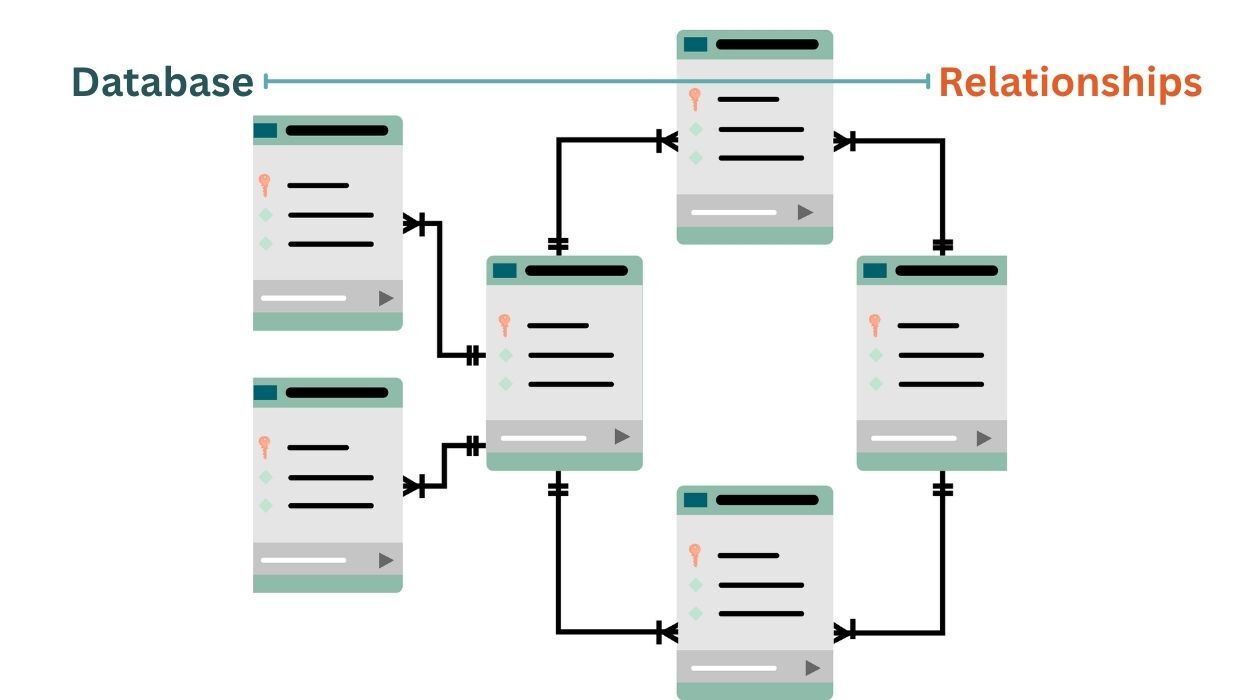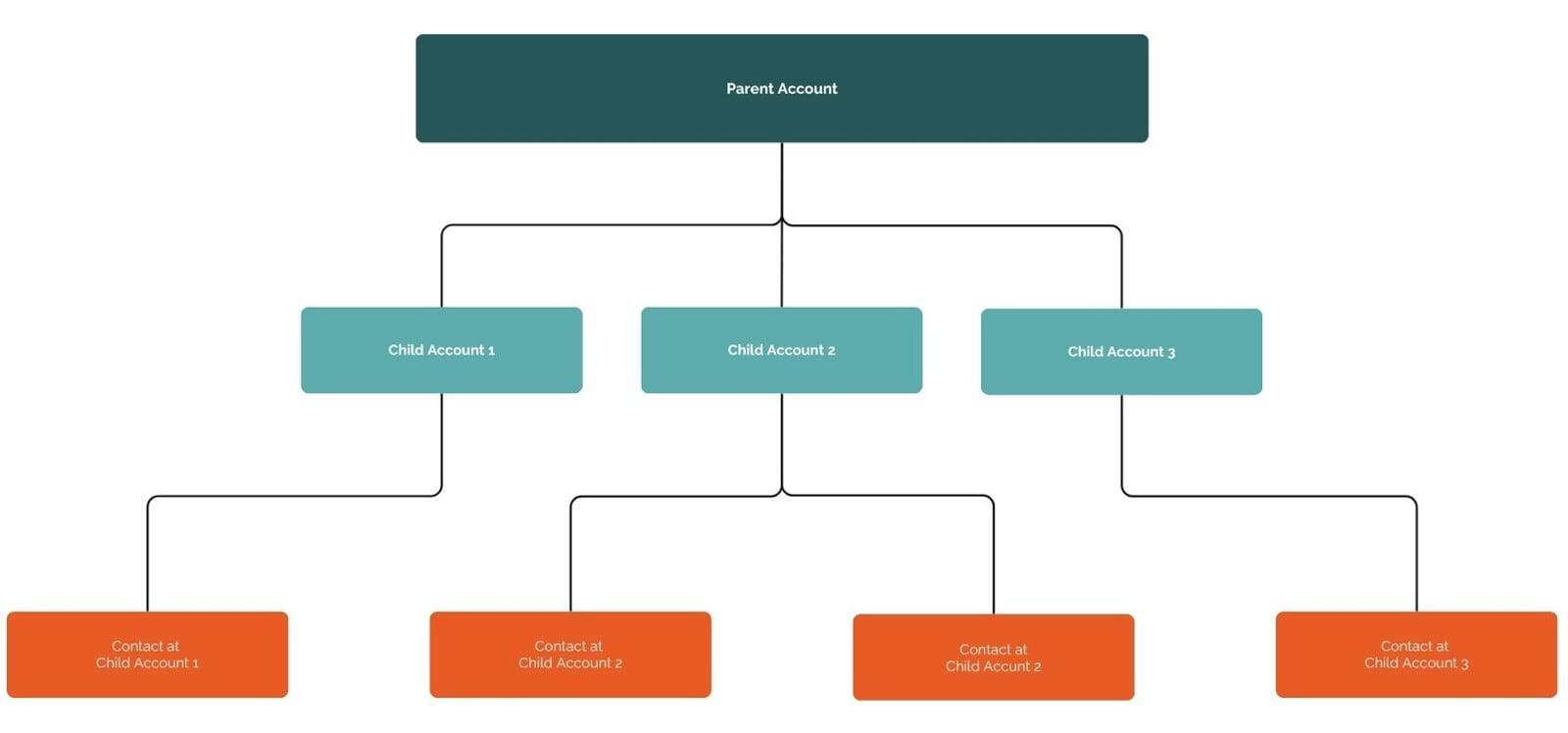
Advanced Database Relationships Unlock Zoho CRM's Full Potential
1. Parent-Child Relationships (Hierarchies)
Zoho CRM uses a Parent-Child relationship structure (like a family or corporate tree) to show how records relate to each other. This is achieved by having a field in the record that points back to another record. A parent-child relationship defines a hierarchy where one record relates to another record.
A parent-child hierarchy is created in Zoho CRM when a module has a lookup field that points to the same module or another module. The lookup field creates a tiered, hierarchical relationship between the linked records.
Example: Corporate Accounts
Problem: Your client has multiple locations each with their own unique details, but you want to show the relationship with the corporate level company.
Solution: Zoho CRM's Accounts module comes with a built-in Parent Account Lookup Field that looks up other records in the Accounts module.
- Setup: Use the Parent Account field to link a subsidiary company record (the Child) to the main holding company (the Parent).
- Result: The Parent Company record will automatically display a Related List showing all its "Child" or subsidiary companies.
- Reporting Power: This structure enables hierarchical reporting, allowing users to see activities, revenue, or other metrics rolled up from all child companies to the parent account, providing a complete view of the enterprise relationship.

2. Beyond One-to-Many: The Power of Many-to-Many Relationships

Check the box "Allow creating relationship-specific modules
What is a Linking Module?
The multi-select lookup field is easy to set up and useful. If you need to take it a step further, then you will want to check the box to create a Linking Module. A Linking Module acts like a middleman or a junction box that connects two other modules, especially when those modules are linked using a multi-select lookup field.
Example: Jack Smith is a prospect who interested in three different Real Estate listings available to rent.
Since you used a multi-select lookup field to connect Jack to those three listings to Jack's Lead record, he is connected to three other records (the listings).
Problem: Jack has requested rent pricing and a tour for the three listings. Where should you save these three different prices and details of his interest in these listings? It can't be on Jack's record, because there are three different prices, not just one. It can't be on the listing's record, because other prospects might be interested. And this isn't quite a "Deal" yet.
Solution: Linking Module called Commissions
To manage this complex relationship—where a specific detail (like the negotiated rent or scheduling a tour) depends on both the prospect and the listing—you can use a Linking Module. When Jack is connected to three listings, three separate records are created in the Linking Module. Each of these new records represents a single, unique link (e.g., Jack + Listing A), allowing you to save a unique Negotiated Rent, a unique Tour Date, and other details for that specific pairing.
This structure not only creates a connection but also supports in-depth tracking.
3. Roll-Up Summary Fields
After setting up relationships throughout your Zoho CRM account, the next natural step is to use Roll-Up Summary Fields to collect aggregated information. These fields greatly improve the value of Related Lists by offering summarized views of the information they contain.
Definition and Function
A Roll-Up Summary Field is a special field on a Parent record (like an Account) that automatically calculates a summary from its related Child records (like Opportunities, Tasks or Contacts).
It works by looking at the data in the "related lists" and performing a calculation—such as finding the total sum, the average value, or the latest date—from all the related records.
Essentially, it lets you see key summarized information (like the total value of all related Deals) in a field directly on the main record, so you don't have to check each related record individually. This feature is only available when a relationship has been properly established between the Parent and Child records.
NOTE: Rollup fields are available for organizations using Enterprise and Ultimate editions only.
Strategic Examples
- Deals Won Revenue: On the Account (Parent) record, create a field that Sums the Won Revenue from all linked Deal records.
- Open Deals Count: Create a field that Counts the number of Open Deals linked to that account.
- Calls/Activity Roll-Up: On a Lead or Contact record, create a field that shows the date and time of the Most Recent Activity (using the MAX function on the activity date field).
Strategic Impact
Roll-up summary fields are how you turn raw data relationships into instant, actionable business intelligence. They provide immediate, high-level summaries on a record without needing to navigate to the Related List or run a separate report, saving time and guiding strategic decisions at a glance.
Transforming Your Zoho CRM Database into Business Intelligence
In this article, we have gone beyond the basic lookup fields to discover the robust relational features available in Zoho CRM. By implementing sophisticated structures like Parent-Child Hierarchies and creating detailed connections using Custom Linking Modules, you transform your CRM from a simple contact list into a robust relational database.
It's the in-depth exploration of Zoho CRM's database relationships that unlocks genuine business intelligence. Whether you are seeking a complete view of a corporate enterprise or tracking complex revenue splits among multiple sales agents, the power lies in how your modules are connected.
The reward for structuring your data correctly is the actionable insight provided by Roll-Up Summary Fields. These features distill vast amounts of transactional data into instantaneous, high-level metrics right on the parent record.
Understanding these concepts is essential to realizing the platform's Enterprise capabilities, enabling your Zoho CRM deployment to become a strategic tool that drives smarter, quicker decisions. If you are seeking to improve the structure of your CRM or expand your knowledge of database relationships, then please reach out to us at any time. We are here to be a resource and support the community.


